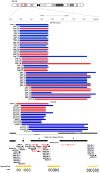Male-biased autosomal effect of 16p13.11 copy number variation in neurodevelopmental disorders
- PMID: 23637818
- PMCID: PMC3630198
- DOI: 10.1371/journal.pone.0061365
Male-biased autosomal effect of 16p13.11 copy number variation in neurodevelopmental disorders
Abstract
Copy number variants (CNVs) at chromosome 16p13.11 have been associated with a range of neurodevelopmental disorders including autism, ADHD, intellectual disability and schizophrenia. Significant sex differences in prevalence, course and severity have been described for a number of these conditions but the biological and environmental factors underlying such sex-specific features remain unclear. We tested the burden and the possible sex-biased effect of CNVs at 16p13.11 in a sample of 10,397 individuals with a range of neurodevelopmental conditions, clinically referred for array comparative genomic hybridisation (aCGH); cases were compared with 11,277 controls. In order to identify candidate phenotype-associated genes, we performed an interval-based analysis and investigated the presence of ohnologs at 16p13.11; finally, we searched the DECIPHER database for previously identified 16p13.11 copy number variants. In the clinical referral series, we identified 46 cases with CNVs of variable size at 16p13.11, including 28 duplications and 18 deletions. Patients were referred for various phenotypes, including developmental delay, autism, speech delay, learning difficulties, behavioural problems, epilepsy, microcephaly and physical dysmorphisms. CNVs at 16p13.11 were also present in 17 controls. Association analysis revealed an excess of CNVs in cases compared with controls (OR = 2.59; p = 0.0005), and a sex-biased effect, with a significant enrichment of CNVs only in the male subgroup of cases (OR = 5.62; p = 0.0002), but not in females (OR = 1.19, p = 0.673). The same pattern of results was also observed in the DECIPHER sample. Interval-based analysis showed a significant enrichment of case CNVs containing interval II (OR = 2.59; p = 0.0005), located in the 0.83 Mb genomic region between 15.49-16.32 Mb, and encompassing the four ohnologs NDE1, MYH11, ABCC1 and ABCC6. Our data confirm that duplications and deletions at 16p13.11 represent incompletely penetrant pathogenic mutations that predispose to a range of neurodevelopmental disorders, and suggest a sex-limited effect on the penetrance of the pathological phenotypes at the 16p13.11 locus.
Conflict of interest statement
Figures

Similar articles
-
Phenotypic manifestations of copy number variation in chromosome 16p13.11.Eur J Hum Genet. 2011 Mar;19(3):280-6. doi: 10.1038/ejhg.2010.184. Epub 2010 Dec 8. Eur J Hum Genet. 2011. PMID: 21150890 Free PMC article.
-
Prenatal Diagnosis, Ultrasound Findings, and Follow-Up Evaluation of 16p13.11 Deletion and Duplication Syndromes: Preliminary Assessment of Fetal Genotype-Phenotype.J Clin Lab Anal. 2025 Jul;39(13):e70051. doi: 10.1002/jcla.70051. Epub 2025 Jun 19. J Clin Lab Anal. 2025. PMID: 40534548 Free PMC article.
-
Ohnologs are overrepresented in pathogenic copy number mutations.Proc Natl Acad Sci U S A. 2014 Jan 7;111(1):361-6. doi: 10.1073/pnas.1309324111. Epub 2013 Dec 24. Proc Natl Acad Sci U S A. 2014. PMID: 24368850 Free PMC article.
-
Copy number variants are frequent in genetic generalized epilepsy with intellectual disability.Neurology. 2013 Oct 22;81(17):1507-14. doi: 10.1212/WNL.0b013e3182a95829. Epub 2013 Sep 25. Neurology. 2013. PMID: 24068782 Free PMC article. Review.
-
16p13.11 microduplication with growth retardation and developmental disorders: a case report and literature review.Nagoya J Med Sci. 2025 Feb;87(1):144-149. doi: 10.18999/nagjms.87.1.144. Nagoya J Med Sci. 2025. PMID: 40256007 Free PMC article. Review.
Cited by
-
Attention-deficit hyperactivity disorder shares copy number variant risk with schizophrenia and autism spectrum disorder.Transl Psychiatry. 2019 Oct 17;9(1):258. doi: 10.1038/s41398-019-0599-y. Transl Psychiatry. 2019. PMID: 31624239 Free PMC article.
-
Whole Exome Sequencing in 16p13.11 Microdeletion Patients Reveals New Variants Through Deductive and Systems Medicine Approaches.Front Genet. 2022 Mar 15;13:798607. doi: 10.3389/fgene.2022.798607. eCollection 2022. Front Genet. 2022. PMID: 35368691 Free PMC article.
-
Sex Differences in Brain Disorders.Int J Mol Sci. 2023 Sep 26;24(19):14571. doi: 10.3390/ijms241914571. Int J Mol Sci. 2023. PMID: 37834018 Free PMC article. Review.
-
Two male adults with pathogenic AUTS2 variants, including a two-base pair deletion, further delineate the AUTS2 syndrome.Eur J Hum Genet. 2015 Jun;23(6):803-7. doi: 10.1038/ejhg.2014.173. Epub 2014 Sep 10. Eur J Hum Genet. 2015. PMID: 25205402 Free PMC article.
-
NDE1 and NDEL1: twin neurodevelopmental proteins with similar 'nature' but different 'nurture'.Biomol Concepts. 2013 Oct;4(5):447-64. doi: 10.1515/bmc-2013-0023. Biomol Concepts. 2013. PMID: 24093049 Free PMC article. Review.
References
-
- Feuk L, Carson AR, Scherer SW (2006) Structural variation in the human genome. Nat Rev Genet 7: 85–97. - PubMed
-
- Iafrate AJ, Feuk L, Rivera MN, Listewnik ML, Donahoe PK, et al. (2004) Detection of large-scale variation in the human genome. Nat Genet 36: 949–951. - PubMed
-
- Sebat J, Lakshmi B, Troge J, Alexander J, Young J, et al. (2004) Large-scale copy number polymorphism in the human genome. Science 305: 525–528. - PubMed
-
- Freeman JL, Perry GH, Feuk L, Redon R, McCarroll SA, et al. (2006) Copy number variation: new insights in genome diversity. Genome Res 16: 949–961. - PubMed
Publication types
MeSH terms
Grants and funding
LinkOut - more resources
Full Text Sources
Other Literature Sources
Medical
Miscellaneous

